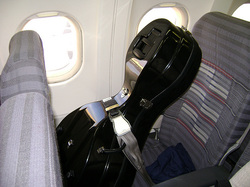
Years after the snakes have been defeated, modern aviation has found a new nemesis: cellos.
Boston-based cellist Paul Katz recently bought a pair of seats – one for himself and another for his 1669 Andrea Guarneri cello – on an American Airlines flight from Calgary to Los Angeles. Only when he arrived at the airport did he learn that American Airlines “code-shares” with WestJet. His flight on American turned into a flight on WestJet – which, unlike AA, doesn’t allow cellos in cabins.
The incident so appalled Katz that he wrote an as-it-happens account of the incident, published in the Boston Globe last week.
“My imagination is out of control,” he noted in mid-flight. "I see my cello in pieces, fingerboard off, cracks in the back and – worst of all – the bridge pushed through the top.”
His fears weren’t unfounded. Stowing instruments in an airplane’s baggage compartment is a risky business – as Canadian country singer Dave Carroll learned in 2008, when his Taylor guitar was damaged on a United Airlines flight. He memorialized the incident in a song, United Breaks Guitars, which became a YouTube hit.
Top-of the-line Taylor guitars sell for about $8,000. But the best cellos are in a different league altogether, commanding prices of more than $1-million.
Baggage handlers may have no idea of a fine cello’s value or fragility, however, treating it just like another piece of luggage. And on top of the risk of damage through mishandling, the changes in air pressure, temperature and humidity that a cello must endure in a baggage compartment can play havoc with a sensitive instrument.
Overhead luggage bins often accommodate small instruments – violins, flutes, clarinets and the like. Large instruments such as harps and double basses must inevitably be stowed in cargo, in specially constructed transportation cases.
But cellos are an in-between size, standing about four-and-a-half feet tall, and this makes the idea of strapping one into a seat a desirable option. Yet policies governing cellos in cabin seats vary from airline to airline – even from plane to plane. And everyone from Transport Canada bureaucrats to airport security staff and pilots is involved in the decision-making process.
Further complicating matters, says Toronto travel agent Rade Sekulic (who specializes in travel arrangements for musicians), is the fact that musicians don’t always know how to deal with airlines and airports.
“When musicians encounter problems at airports, they can become very negative,” he says. “They don’t understand how the channels work – or what to do if someone says no. So to prevent problems, musicians should inform airlines in advance, and get an acknowledgment that they can bring a cello, or other instrument, on board.”
On many Air Canada flights, cellists can buy an extra seat for their instruments, which are then secured with a special net.
Porter Airlines has no such equipment – but a lucky musician may be allowed to place a cello in an on-board closet, if space permits.
Then there’s WestJet, which won’t make any special arrangements for cellos in the passenger cabin – and has no plans to do so.
“The demand for this service is insufficient to justify the cost, time and resources involved in launching the certification,” says WestJet spokesman Robert Palmer. “We fly roughly 16 million guests each year, and receive at most a handful of telephone calls from guests asking if they may purchase a seat for their cello.”
“I find that outrageous,” Katz says. “If that’s their policy, the least they could do is program their online computer system so it won’t accept a booking for a cello.”
After four decades of flying around the world with his precious instrument, Katz has learned which airlines are cello-friendly and which aren’t. And the least accommodating, in his experience, are Canadian.
“I hate to say it,” he says, “but of all the countries I’ve been in, Canada is the worst for flying with a cello.”
Katz isn’t the first cellist with a fear of flying with an instrument stowed in baggage. The late Canadian cellist Zara Nelsova famously once became so frustrated with an airline official who told her that passengers couldn’t board with cellos that she attempted to pass hers off as an exotic folk instrument.
“It’s not a cello,” she protested indignantly, “it’s a jumbo balalaika!”
© Colin Eatock 2012
PS: Subsequent to publication, I received a message from Greg Sheldon of the Organization of Canadian Symphony Musicians, pointing out that the U.S. Congress recently passed a law stating that airlines must allow instruments that can fit in a seat (i.e. cellos) into the passenger cabin. However, this law doesn’t come into effect until next February – and it will not apply to Canada, unless Transport Canada changes its policies.
 RSS Feed
RSS Feed

